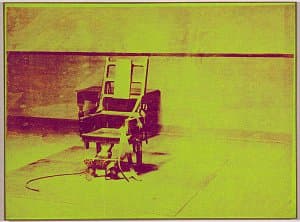

Andy Warhol
Learn moreElectric chair 1967
© The Andy Warhol Foundation for the Visual Arts, Inc./ARS. Licensed by Copyright Agency Purchased 1977
More detail | PermalinkAndy Warhol first used the image of the electric chair in his Death and disaster series, a loose group of works that occupied him from 1962–65. The artist noted that it was Henry Geldzahler, a curator at the Metropolitan Museum of Art, New York, who:
gave me the idea to start the Death and Disaster series. We were both having lunch one day in the summer [of 1962] … and he laid the Daily News out on the table. The headline was ‘129 DIE IN JET’, and that’s what started me on the death series—the Car Crashes, the Disasters, the Electric Chairs …[1]
As well as wrecked cars and electric chairs, the Death and disaster series pictures suicides, the atomic bomb, civil rights protests and people ‘unwittingly poisoned by contaminated tuna-fish’.[2] These deliberately shocking, grainy images sourced from headlines and newspapers are made deadpan through repetition, colour and surface. The image of the death chamber and ‘Old sparky’—the chair at Sing-Sing prison in Ossining, New York—is after a January 1953 press photograph announcing the execution of Julius and Ethel Rosenberg, who were convicted of espionage for conspiring to sell nuclear secrets to the Soviet Union.[3] Three groups of paintings resulted in 1963, 1965 and 1967. The first series of Electric chairs uses repeated images of the empty room, including the ‘silence’ sign above the door at right.
When Warhol’s Electric chairs had their debut at the Sonnabend Gallery, Paris, in 1964 they were interpreted as a sardonic comment about the sinister side of the American dream, as Philip Brophy has observed:
If Warhol is about America, then the electric chair is the seat of American culture. Like a transmogrified porch rocking chair, this fusion of Gothic American folk and maverick industrial inventiveness declares its own ingenuity as applied to the act of killing ... Most importantly, the emptied tonality of the image through Warhol’s unperturbed importation filters out all humanist distortion to allow the image to deeply resonate ... the image becomes death in order to demonstrate death.[4]
In 1967, in preparation for his retrospective at the Moderna Museet, Stockholm, the following year, Warhol re-used the image of a single chair, this time more tightly cropped, for a series of 14 paintings in different colour combinations.[5] The single image was used again for Warhol’s portfolio of 10 screenprints published by Bruno Bischofberger, Zurich, in 1971.
Lucina Ward[6]
[1] Andy Warhol and Pat Hackett, POPism: The Warhol ’60s, Harcourt Brace Jovanovich, New York and London, 1980, p 75.
[2] See, for example, 129 die in jet (Plane crash) 1962, Museum Ludwig, Cologne.
[3] News wire service dated 13 January 1953; see http://hyperallergic.com/wp-content/uploads/2016/06/warhol-electric-chairs-Photograph-Sing-Sing-Death-Chamber.jpg, accessed 5 April 2018.
[4] Philip Brophy, ‘Die Warhol die’, in Andy Warhol, Queensland Art Gallery, Brisbane, 2007, p 73.
[5] 40 works in total christies.com, accessed 5 April 2018.
[6] Adapted and updated from Michael Lloyd and Michael Desmond, European and American paintings and sculptures 1870–1970 in the Australian National Gallery, Australian National Gallery, Canberra, 1992, pp 328–30.

